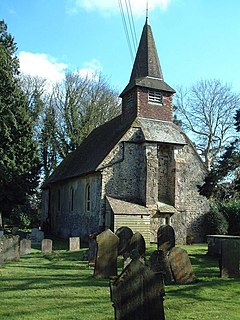
Cartmel Priory church serves as the parish church of Cartmel, Cumbria, England.

Winchelsea is a town in the county of East Sussex, England, located between the High Weald and the Romney Marsh, approximately 2 miles (3.2 km) south west of Rye and 7 miles (11 km) north east of Hastings. The current town, which was founded in 1288, replaced an earlier town of the same name, known as Old Winchelsea, that was lost to coastal erosion in the late medieval period. Winchelsea is part of the civil parish of Icklesham.

Dunton is a village and civil parish in the Aylesbury Vale district of Buckinghamshire, England. The village is situated approximately 8 miles (13 km) north from Aylesbury and 4 miles (6.4 km) south-east from Winslow.
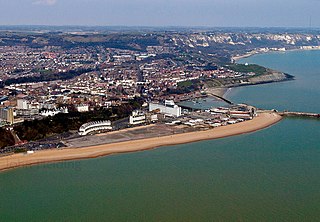
Folkestone and Hythe is a local government district in Kent, England. It lies in the south-east of the county, on the coast of the English Channel. The district was formed in 1974 and was originally named Shepway after one of the ancient lathes of Kent, which had covered a similar area. The district was renamed in 2018. The council is based in Folkestone, the district's largest town. The district also includes the towns of Hawkinge, Hythe, Lydd and New Romney, along with numerous villages and surrounding rural areas.

Postling is a village and civil parish situated near the Roman road of Stone Street, about 17 miles (27 km) south of Canterbury, Kent, in South East England. Postlinges is the spelling used in the Domesday Book, where it was part of the lands of Hugo de Montfort; Postlinge is also seen in old records. There is much archaeological evidence of continued occupation of the area. Postling Court is, in effect, the old manor-house, although is, more correctly as the name suggests, the one-time meeting place of the local court and magistrate. The population of the civil parish includes the hamlet of Newbarn.

Hawkinge is a town and civil parish in the Folkestone and Hythe district of Kent, England. The original village of Hawkinge is actually just less than a mile due east of the present village centre; the village of Hawkinge was formed by the merging of Hawkinge and Uphill.
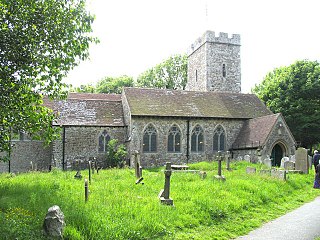
Cheriton is a northern suburb of Folkestone, in the Folkestone and Hythe, in the county of Kent, England. It is the location of the English terminal of the Channel Tunnel as well as of the major army barracks of Shorncliffe Camp.
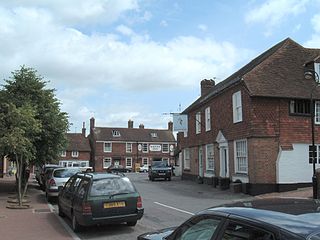
Rotherfield is a village and civil parish in the Wealden District of East Sussex, England. It is one of the largest parishes in East Sussex. There are three villages in the parish: Rotherfield, Mark Cross and Eridge. The River Rother, which drains much of the county and discharges at Rye Harbour, has its source on the south side of the hill on which Rotherfield village is built.

Elham is a village and civil parish in East Kent situated approximately 9 miles (14 km) south of Canterbury and 5 miles (8 km) north west of Folkestone in the Elham Valley. At the 2011 Census the population included the hamlet of Ottinge and village of Wingmore.
Folkestone Priory was a pre-Reformation Benedictine monastery at Folkestone in the English county of Kent. The priory church survives as the present parish church. It was the successor to Folkestone Abbey, an Anglo-Saxon nunnery on a different site.
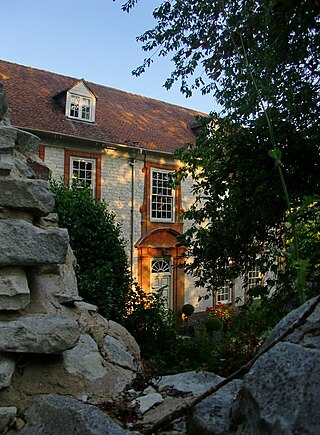
Treyford is a hamlet, Anglican parish and former civil parish, now in the civil parish of Elsted and Treyford, in the Chichester district of West Sussex, England. The hamlet sits on the Elsted to Bepton Road 4 miles (6.4 km) southwest of Midhurst. In 1931 the civil parish had a population of 104.

Trimley St. Martin is a village and civil parish in the East Suffolk district, in the county of Suffolk, England. It lies between the rivers Orwell and the Deben, on the long narrow tongue of land from Ipswich to Felixstowe referred to as the Colneis Hundred. In 2011 the parish had a population of 1942.

Stelling Minnis is a village and civil parish in the Folkestone and Hythe district in Kent, England. The village lies 13 kilometres (8 mi) to the south of Canterbury, and to the east of the B2068, Stone Street, the Roman road, which takes traffic between Lympne and Canterbury.

West Hythe is a hamlet and former civil parish, now in the parish of Hythe, in the Folkestone and Hythe district, in Kent, England, near Palmarsh and a few miles west of the cinque port town of Hythe. In 2020 it had an estimated population of 566.

Shocklach Oviatt is a former civil parish, now in the parish of Shocklach Oviatt and District, in the unitary authority of Cheshire West and Chester and the ceremonial county of Cheshire, England. The parish of Shocklach comprised the townships Shocklach Oviatt, Church Shocklach and Caldecott. The civil parish was abolished in 2015 to form Shocklach Oviatt and District.
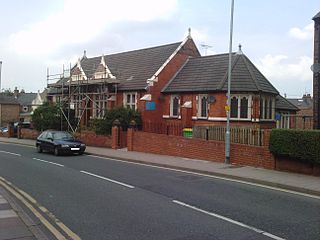
The Church of St. Thomas of Canterbury is an active Anglican parish church situated in the City of Chester, in an area of the city informally known as "The Garden Quarter", a densely populated area, close to the University. The church was built in 1872, but the parish of St. Oswald which it serves is much older, dating back to about 980 AD. One of the earliest references to St. Oswald's can be found in Bradshaw's. The parish registers date back to 1580. The church is recorded in the National Heritage List for England as a designated Grade II listed building. The church is part of the diocese of Chester, the archdeaconry of Chester and the deanery of Chester. The patrons of the parish are the dean and chapter of Chester Cathedral.

Houghton is a small village and a civil parish in the English county of Norfolk. It covers an area of 7.64 km2 (2.95 sq mi) and had a population of 69 in 36 households at the 2001 census. At the 2011 census the population of the parish was again below 100, and was therefore included in the civil parish of West Rudham.

Ramsden is a village and civil parish about 3+1⁄2 miles (5.6 km) north of Witney in West Oxfordshire. The 2011 Census recorded the parish's population as 342.
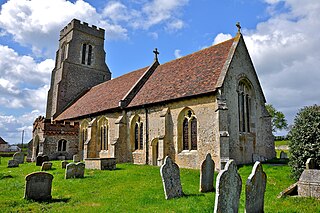
Hawkedon is a village and civil parish in the West Suffolk district of Suffolk in eastern England. Located around 7 miles (11 km) south-south-west of Bury St Edmunds, the parish also contains the hamlet of Thurston End, and in 2005 had a population of 120. The majority of the village is classed as a conservation area.

Denton with Wootton is a civil parish in the Dover District of Kent, England. The parish contains the settlements of Denton and Wootton, 1 mile (1.6 km) apart. In 2011 it had a population of 372.
